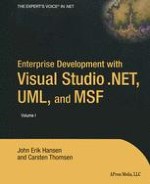Using Visual Studio .NET (VS .NET) for creating enterprise solutions, authors John Hansen and Carsten Thomsen have chosen to add the Unified Modeling Language (UML), for designing and documenting solutions, and the Microsoft Solutions Framework (MSF), for planning and managing projects.
Experienced developers, team leaders, and project managers who need a structured way of creating enterprise solutions will benefit from reading this book. Parts of this book can be used by developers (experienced or not) and managers who want to know about MSF and UML in connection with .NET development.
This guide provides an enterprise development overview, an in-depth introduction to UML, and coverage of various enterprise tools included with the VS .NET Enterprise Developer (VSED) and VS .NET Enterprise Architect (VSEA) editions, such as enterprise template projects, Visual SourceSafe (VSS), Visio for Enterprise Architects 2003 (VEA), Microsoft Application Center Test (ACT), and Visual Studio Analyzer.
Not only will you learn how to deploy your project, but also two hands-on chapters will show you how to analyze your project and model it using VEA, and guide you step-by-step through the process.
For most readers, this is a cover-to-cover book, but it can certainly be used as a reference guide whenever you need information about a particular tool or process. Throughout this book, youll find exercises that demonstrate the topic being discussed, making this book a must-have for programmers dealing with, or those with an interest in, developing enterprise .NET solutions.
